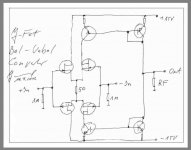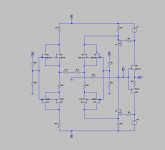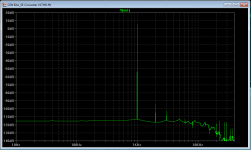Here we go.....
It works extremely well, i tried a BJT version in a phono stage.
Maybe move the diode-connected transistors to be the loads of the JFET drains instead of the output devices?
Brad
Sure, this came right out of my head.
I knew that 😀 It's one of those cases where we know so well what is intended that we can't "see" what we've drawn.
The other option is to use one half of a blowtorch.
But I don't really like adding another stage.
When Joachim finalises his design, we'll make a proto.
Just like your buffer filter. How does that sound ?
😉
Patrick
But I don't really like adding another stage.
When Joachim finalises his design, we'll make a proto.
Just like your buffer filter. How does that sound ?
😉
Patrick
Paul,
Please try one phase of SEN in yours and report back.
In our AD1865 setup, it is dead quiet on one phase, with 1k R_iv.
If it is noisy in yours, then it is either the 9018 itself, or 9018 board layout.
Patrick
Please try one phase of SEN in yours and report back.
In our AD1865 setup, it is dead quiet on one phase, with 1k R_iv.
If it is noisy in yours, then it is either the 9018 itself, or 9018 board layout.
Patrick
Of course. Stupid me.
Still, no reason that one phase of 9018 should be noise.
But we better measure the chip ourselves before making more comments.
Patrick
Still, no reason that one phase of 9018 should be noise.
But we better measure the chip ourselves before making more comments.
Patrick
Hi Patrick
I just tried taking a SE output from SEN, one channel only. It seems fine- certainly the gross distortion I found with the other IV stages is gone! I checked both channels, and both + and - phases. Final confirmation will have to wait until I can listen critically in stereo, but I think the "problem" is solved!
Paul
I just tried taking a SE output from SEN, one channel only. It seems fine- certainly the gross distortion I found with the other IV stages is gone! I checked both channels, and both + and - phases. Final confirmation will have to wait until I can listen critically in stereo, but I think the "problem" is solved!
Paul
Broskie cathode follower 😀:Do you have a specific suggestion on how to use the SEN I/V-stage with single ended (SE) amps?
Balanced-Ouput DACs and Tubes and Aikido
Last edited:
CEN Balanced to Single Ended Converter
I did a quick simulation of the circuit in #1021, but distortion is quite high (-40dB 3rd).
Of course by no means optimised yet, and still potential for improvement.
But I also adapted one of my circuits in the drawer for BAL->SE conversion.
The perfromance is excellent in Spice.
And with the added bonus of all FET, no global feedback (my prejudice).
🙂
Patrick
I did a quick simulation of the circuit in #1021, but distortion is quite high (-40dB 3rd).
Of course by no means optimised yet, and still potential for improvement.
But I also adapted one of my circuits in the drawer for BAL->SE conversion.
The perfromance is excellent in Spice.
And with the added bonus of all FET, no global feedback (my prejudice).
🙂
Patrick
Attachments
But I also adapted one of my circuits in the drawer for BAL->SE conversion.
...
Patrick
You seem to be in the mood for throwing up circuits.
How about a fully balanced, single stage output stage that can be driven directly from a stepped attenuator used as a Sen i/v resistor.
Make a nice headphone/low power amp.
I think I'm getting 6V pk-pk from the last Sen variant I posted (with RM=0R) with a 750R Riv and measuring -100dB 2nd and 3rd harmonic.
Not sure what the useful limit is for Riv. Enough, anyway, for a small amp with no extra gain stage.
Patrick, i like they way you use my idea with a folded mosfet cascode and buffer. I think this is the way we should go. My original circuit can be improved with better mirrors and buffers but your solution is somewhat lower in parts count and already simulates very well. I would be very interested if you make a board from it.
That bal-unbal problem shows up very often. Most people simply do not have a totally balanced system and what we are doing here may be one of the few high quality bal-unbal
converters with discrete components.
That bal-unbal problem shows up very often. Most people simply do not have a totally balanced system and what we are doing here may be one of the few high quality bal-unbal
converters with discrete components.
The circuit shown in post #1034 is nothing other than a Blowtorch look-alike with the second stage of the negative phase removed, and a complementary source follower added to lower the output impedance. The first stage can of course only be 4 JFETs instead of 8.
So the credit goes to John Curl I am afraid. 😉
I already have a board for this but it is too large because I used TO220 MOSFETs at 70mA for the second stage. So still some room for optimisation. But one can equally use one half of Nelson's Pass UGS to achieve the same purpose.
Patrick
Patrick
So the credit goes to John Curl I am afraid. 😉
I already have a board for this but it is too large because I used TO220 MOSFETs at 70mA for the second stage. So still some room for optimisation. But one can equally use one half of Nelson's Pass UGS to achieve the same purpose.
Patrick
Patrick
Sure, but i have not seen to use the input stage used that way ( plus simplified ) and i wanted to prove that a simple and good bal-unbal can be made.
That was not the case two days ago.
That was not the case two days ago.
It would seem that possibly a more felicitous approach would use the outputs of the Sens as current sources, rather than converting to voltages and then proceeding with the bal-unbal conversion. Just a thought.
In the contend of the SEN that makes sense but the circuit post 1034 is more universal.
I have a project where i need exactly this so i will try it.
The positive source follower is supplied by resistors. Where the resistors meet the drains i would put electrolytics to ground.
I have a project where i need exactly this so i will try it.
The positive source follower is supplied by resistors. Where the resistors meet the drains i would put electrolytics to ground.
- Home
- Source & Line
- Digital Line Level
- Zen -> Cen -> Sen, evolution of a minimalistic IV Converter


